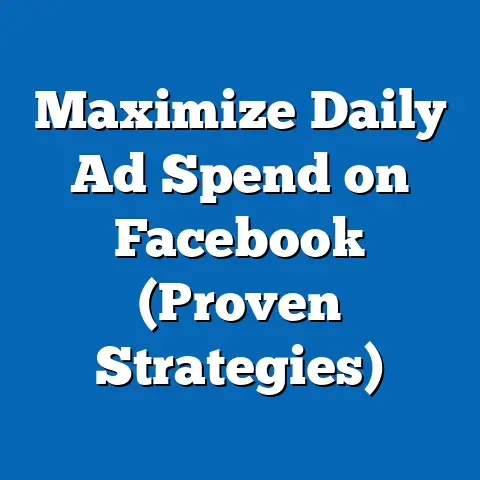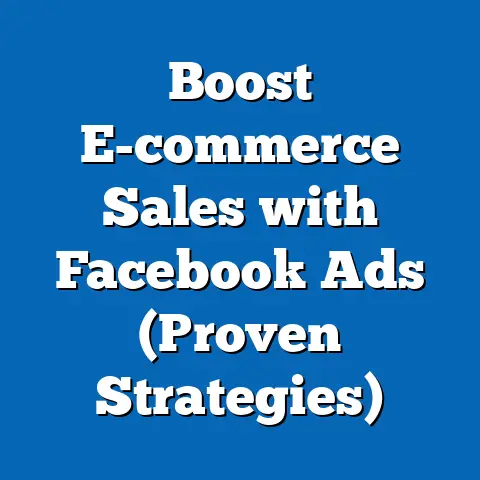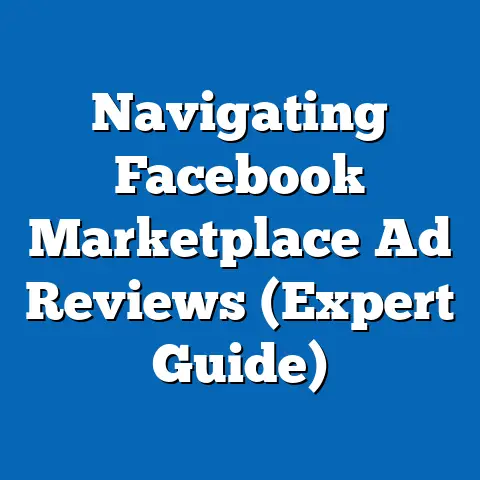Maximize Facebook Wallet Ads ROI (Proven Strategies Inside)
In today’s fast-paced digital world, where every penny counts, businesses are constantly searching for ways to stretch their marketing budgets further. Many see Facebook ads as a short-term investment, a quick boost to sales, but I’ve learned through years of experience that they can be so much more. When executed strategically, Facebook ads, especially Wallet Ads, can lead to substantial long-term savings and a significant increase in revenue. Think of it as planting a seed today that blossoms into a thriving tree tomorrow.
I’ve seen countless businesses, both big and small, struggle to make the most of their Facebook advertising. They throw money at ads without a clear strategy, hoping for the best, only to be disappointed with the results. It’s like throwing darts in the dark. But what if you had a flashlight and a clear target? That’s what I aim to provide in this guide: a clear roadmap to maximize your ROI on Facebook Wallet Ads and turn them into a powerful, cost-effective tool for your business. With the rise of mobile payment solutions, understanding and leveraging Facebook Wallet Ads is more critical than ever. Consumers are increasingly shopping online and using mobile wallets for convenience, making Wallet Ads a key component of a successful modern marketing strategy.
Section 1: Understanding Facebook Wallet Ads
Facebook Wallet Ads are a specific type of advertising campaign designed to seamlessly integrate with mobile payment solutions. They allow potential customers to make purchases directly through the Facebook app, streamlining the buying process and reducing friction. These ads are tailored to users who have payment information stored within their Facebook account, making it incredibly easy for them to complete transactions.
The mechanics of Wallet Ads are quite straightforward. When a user clicks on a Wallet Ad, they are prompted to complete the purchase using their saved payment information. This eliminates the need to manually enter credit card details or shipping addresses, which can often deter potential buyers. Wallet Ads can be placed in various locations within the Facebook ecosystem, including the news feed, Marketplace, and even within Messenger conversations. The flexibility of placement ensures that businesses can reach their target audience where they are most active.
Different types of businesses can benefit from Wallet Ads, but I’ve found that they are particularly effective for e-commerce stores, subscription services, and businesses offering digital products. For example, an online clothing retailer can use Wallet Ads to showcase new arrivals and allow customers to make purchases with just a few taps. Similarly, a subscription box service can use Wallet Ads to offer exclusive discounts and encourage sign-ups. This is especially useful for businesses targeting millennials and Gen Z, who are most likely to use mobile payment solutions.
The rise of mobile payment solutions like Apple Pay, Google Pay, and PayPal is undeniable. According to Statista, mobile payments are projected to reach \$4.9 trillion in 2024 globally, and this trend is only expected to continue. Wallet Ads cater directly to this trend, providing a seamless and convenient shopping experience for mobile users. By understanding and utilizing Wallet Ads, businesses can tap into this growing market and capture a significant share of online sales.
Key Takeaway: Facebook Wallet Ads are designed to simplify the online shopping experience for mobile users, making it easier for them to make purchases directly through the Facebook app. They cater to the growing trend of mobile payment solutions and can be particularly effective for e-commerce stores and subscription services.
Section 2: The Importance of ROI in Advertising
ROI, or Return on Investment, is a crucial metric that helps businesses understand the profitability of their advertising campaigns. In the context of Facebook advertising, specifically Wallet Ads, ROI measures the amount of revenue generated for every dollar spent on advertising. It’s not just about making sales, it’s about making profitable sales.
To calculate ROI for Facebook Wallet Ads, you need to consider all the costs associated with the campaign, including ad spend, creative costs, and any other related expenses. Then, you need to subtract those costs from the revenue generated by the ads and divide the result by the total cost. The formula looks like this:
ROI = (Revenue – Cost) / Cost
For example, if you spend \$1,000 on a Wallet Ads campaign and generate \$3,000 in revenue, your ROI would be:
ROI = (\$3,000 – \$1,000) / \$1,000 = 2 or 200%
This means that for every dollar you spent on advertising, you generated two dollars in revenue. A higher ROI indicates a more profitable campaign.
Businesses should track several key metrics to measure ROI effectively. These include:
- Click-Through Rate (CTR): Measures the percentage of people who click on your ad after seeing it. A higher CTR indicates that your ad is engaging and relevant to your target audience.
- Conversion Rate: Measures the percentage of people who take a desired action, such as making a purchase, after clicking on your ad. A higher conversion rate indicates that your ad is effectively driving sales.
- Cost Per Acquisition (CPA): Measures the cost of acquiring a new customer through your advertising campaign. A lower CPA indicates that you are acquiring customers efficiently.
- Customer Lifetime Value (CLTV): Measures the total revenue a customer is expected to generate over their relationship with your business. A higher CLTV indicates that you are acquiring valuable, long-term customers.
By tracking these metrics, businesses can gain valuable insights into the performance of their Wallet Ads campaigns and identify areas for improvement.
I’ve seen firsthand how a well-optimized Wallet Ads strategy can lead to significant returns over time. For instance, a local bakery I worked with implemented a targeted Wallet Ads campaign offering a discount on their signature cupcakes. By focusing on a specific demographic and using compelling visuals, they saw a 300% increase in cupcake sales within the first month. Their ROI was incredibly high, proving that even small businesses can benefit from a strategic approach to Wallet Ads. According to a study by Facebook, businesses that use targeted advertising see a 20% increase in sales compared to those that use broad targeting.
Key Takeaway: ROI is a critical metric for measuring the profitability of Facebook Wallet Ads campaigns. By tracking key performance indicators like CTR, conversion rate, CPA, and CLTV, businesses can gain valuable insights into ad performance and optimize their strategies for maximum returns.
Section 3: Proven Strategies to Maximize ROI on Facebook Wallet Ads
Maximizing ROI on Facebook Wallet Ads requires a strategic approach that encompasses everything from audience targeting to ad creative and budget optimization. Here are six proven strategies that I’ve found to be particularly effective:
Strategy 1: Targeting the Right Audience
Precise audience targeting is the cornerstone of any successful Facebook advertising campaign. It’s like aiming a rifle instead of a shotgun. The more accurately you can identify and target your ideal customer, the higher your ROI will be. Facebook offers a wealth of targeting options that allow you to reach specific demographics, interests, behaviors, and even connections.
To start, define your ideal customer. Who are they? What are their interests? What are their pain points? Once you have a clear picture of your target audience, you can use Facebook’s targeting tools to reach them.
- Demographic Targeting: This allows you to target users based on age, gender, education, location, and other demographic factors. For example, if you’re selling baby products, you can target parents with young children.
- Interest Targeting: This allows you to target users based on their interests and hobbies. For example, if you’re selling fitness equipment, you can target users who are interested in fitness, health, and wellness.
- Behavior Targeting: This allows you to target users based on their online behavior, such as their purchase history and browsing habits. For example, if you’re selling travel packages, you can target users who have recently searched for flights or hotels.
- Connection Targeting: This allows you to target users who are connected to your Facebook page or have interacted with your ads in the past. This can be a great way to re-engage existing customers and build brand loyalty.
Creating custom audiences and lookalike audiences can also significantly improve your targeting efforts.
- Custom Audiences: These are audiences that you create based on your existing customer data, such as email lists or website traffic. You can upload your customer data to Facebook and create a custom audience to target those users with your ads.
- Lookalike Audiences: These are audiences that Facebook creates based on your existing custom audiences. Facebook analyzes the characteristics of your custom audience and identifies other users who share similar traits. This can be a great way to reach new customers who are likely to be interested in your products or services.
Strategy 2: Crafting Compelling Ad Copy and Imagery
Your ad copy and imagery are the first things that potential customers will see, so it’s crucial to make a strong impression. Your ad copy should be clear, concise, and compelling, highlighting the benefits of your product or service and urging users to take action. Think of it as a mini-sales pitch.
Here are some best practices for writing engaging ad copy:
- Use a strong headline: Your headline should grab attention and clearly communicate the value proposition of your ad.
- Highlight the benefits: Focus on the benefits of your product or service, rather than just the features. How will it make their life better?
- Use a clear call to action: Tell users exactly what you want them to do, such as “Shop Now,” “Learn More,” or “Sign Up.”
- Keep it concise: People have short attention spans, so get to the point quickly.
High-quality visuals and videos are also essential for capturing attention and enhancing ad performance. Your visuals should be eye-catching, relevant to your product or service, and optimized for mobile devices.
- Use high-resolution images: Blurry or pixelated images will turn people off.
- Showcase your product: Let people see what they’re buying.
- Use video: Video is a highly engaging medium that can capture attention and communicate your message effectively.
- Optimize for mobile: Most Facebook users are on mobile devices, so make sure your visuals look good on small screens.
Strategy 3: Utilizing A/B Testing
A/B testing, also known as split testing, is a method of comparing two versions of an ad to see which one performs better. It’s like running a science experiment on your ads. By testing different ad variations, you can identify the most effective elements and optimize your campaigns for maximum ROI.
To set up an A/B test, you need to create two versions of your ad that are identical except for one element. For example, you might test two different headlines, two different images, or two different calls to action.
- Headlines: Test different headlines to see which one generates the most clicks.
- Images: Test different images to see which one captures the most attention.
- Calls to action: Test different calls to action to see which one drives the most conversions.
- Targeting: Test different targeting options to see which one reaches the most relevant audience.
Once you have your two ad variations, you can set up an A/B test in Facebook Ads Manager. Facebook will then show each ad variation to a random sample of your target audience and track the performance of each ad.
After a certain period, you can analyze the results of your A/B test to see which ad variation performed better. The winning ad variation is the one that generated the most clicks, conversions, or other desired actions.
Strategy 4: Leveraging Facebook Pixel for Retargeting
Facebook Pixel is a small piece of code that you can install on your website to track the actions that people take on your site after clicking on your Facebook ad. It’s like having a digital footprint tracker. This data can be used to create retargeting campaigns, which are ads that are shown to people who have previously interacted with your website.
Retargeting can significantly increase conversion rates and drive higher ROI. For example, if someone visits your website but doesn’t make a purchase, you can show them a retargeting ad featuring the products they viewed. This reminds them of your product and encourages them to come back and complete the purchase.
To set up Facebook Pixel, you need to go to Facebook Ads Manager and create a new pixel. Facebook will then provide you with a code snippet that you can install on your website.
Once you have installed Facebook Pixel, you can start tracking the actions that people take on your website, such as page views, product views, and purchases. This data can be used to create custom audiences and retargeting campaigns.
Strategy 5: Optimizing Ad Spend and Budgeting
Optimizing your ad spend and budgeting is crucial for maximizing ROI on Facebook Wallet Ads. It’s not just about spending money, it’s about spending it wisely. You need to allocate your budget effectively across campaigns to ensure that you are getting the most bang for your buck.
There are two main types of bidding strategies that you can use on Facebook:
- Automatic Bidding: This is where Facebook automatically sets your bids based on your budget and targeting options. This is a good option for beginners who are not familiar with bidding strategies.
- Manual Bidding: This is where you manually set your bids based on your desired cost per click (CPC) or cost per acquisition (CPA). This gives you more control over your ad spend, but it also requires more expertise.
Regardless of which bidding strategy you choose, it’s important to monitor your ad performance regularly and adjust your spending based on the results.
- Start with a small budget: Don’t start by spending a lot of money on your ads. Start with a small budget and gradually increase it as you see results.
- Monitor your ad performance: Keep a close eye on your ad performance and adjust your spending based on the results.
- Pause underperforming ads: If an ad is not performing well, pause it and try a different ad variation.
- Reallocate your budget: If one campaign is performing better than another, reallocate your budget to the better-performing campaign.
Strategy 6: Incorporating User-Generated Content
User-generated content (UGC) is content that is created by your customers, such as reviews, testimonials, and photos. It’s like having an army of brand advocates. Incorporating UGC into your Wallet Ads can build trust and authenticity, which can significantly improve your ROI.
People are more likely to trust the opinions of other customers than they are to trust advertising claims. By featuring UGC in your ads, you can show potential customers that other people have had positive experiences with your product or service.
- Ask for reviews: Encourage your customers to leave reviews on your Facebook page or website.
- Run contests: Run contests and ask your customers to submit photos or videos featuring your product.
- Feature UGC in your ads: Use UGC in your ads to build trust and authenticity.
Key Takeaway: Maximizing ROI on Facebook Wallet Ads requires a strategic approach that encompasses audience targeting, ad creative, A/B testing, retargeting, budget optimization, and user-generated content. By implementing these strategies, businesses can significantly improve their ad performance and drive higher returns.
Section 4: Measuring and Analyzing Success
Measuring and analyzing the success of your Facebook Wallet Ads campaigns is essential for ongoing improvement and maximizing ROI. It’s like checking the compass to make sure you’re heading in the right direction. You need to monitor key performance indicators (KPIs) to assess the effectiveness of your ads and identify areas for improvement.
Some of the most important KPIs to track include:
- Reach: The number of people who saw your ad.
- Impressions: The number of times your ad was displayed.
- Click-Through Rate (CTR): The percentage of people who clicked on your ad after seeing it.
- Conversion Rate: The percentage of people who took a desired action, such as making a purchase, after clicking on your ad.
- Cost Per Click (CPC): The cost of each click on your ad.
- Cost Per Acquisition (CPA): The cost of acquiring a new customer through your advertising campaign.
- Return on Ad Spend (ROAS): The amount of revenue generated for every dollar spent on advertising.
Facebook Analytics provides a wealth of data and insights on your ad performance. You can use Facebook Analytics to track these KPIs and identify trends and patterns in your data.
- Track your KPIs regularly: Monitor your KPIs on a daily or weekly basis to identify any changes in your ad performance.
- Analyze your data: Look for trends and patterns in your data to identify areas for improvement.
- Use A/B testing: Use A/B testing to test different ad variations and identify the most effective elements.
- Adjust your strategies: Based on your data and analysis, adjust your strategies to improve your ad performance.
Continually refining your strategies based on data-driven decisions is crucial for ensuring ongoing improvement in ROI. Don’t be afraid to experiment with different ad variations, targeting options, and bidding strategies. The key is to stay flexible and adapt your approach based on what the data tells you.
Key Takeaway: Measuring and analyzing the success of your Facebook Wallet Ads campaigns is essential for ongoing improvement and maximizing ROI. By tracking key performance indicators and using Facebook Analytics, businesses can gain valuable insights into ad performance and refine their strategies for maximum returns.
Conclusion
Maximizing ROI through effective strategies for Facebook Wallet Ads is not just about running ads; it’s about running smart ads. While the initial investment may seem daunting, the potential for long-term savings and profitability is immense when these strategies are executed diligently. It’s like investing in a well-diversified portfolio; the returns may not be immediate, but over time, they can be substantial.
I’ve shared a range of proven strategies in this guide, from precise audience targeting and compelling ad creative to A/B testing, retargeting, budget optimization, and user-generated content. Each of these strategies plays a crucial role in maximizing your ROI and turning your Facebook Wallet Ads into a powerful, cost-effective tool for your business.
Don’t just read this guide and forget about it. Take action and implement the strategies discussed to start seeing tangible results in your advertising efforts. Start small, experiment with different approaches, and track your results closely. The more you learn and adapt, the better your results will be.
Remember, Facebook Wallet Ads are not just about making sales; they’re about building relationships with your customers, creating brand awareness, and driving long-term growth. By focusing on these goals and implementing the strategies outlined in this guide, you can unlock the full potential of Facebook Wallet Ads and achieve a significant return on your investment. So go ahead, take the leap, and start maximizing your ROI today!






